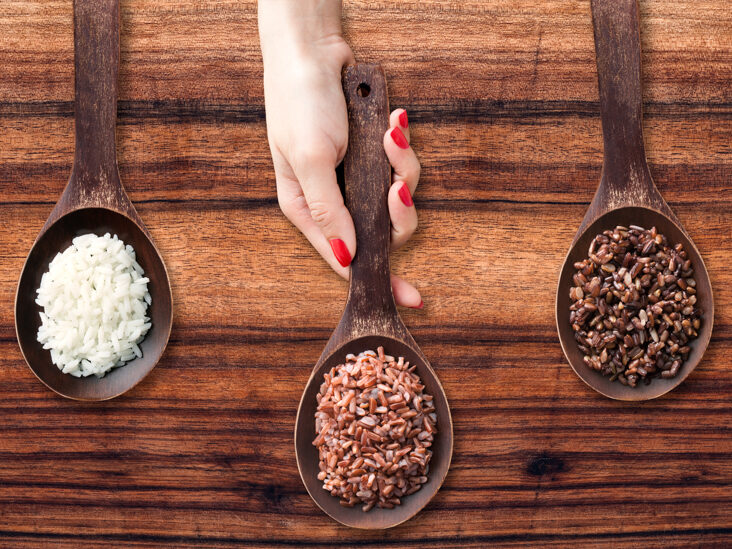Rice is a versatile grain consumed by people around the world.
It serves as a staple food for many people, especially those living in Asia.
Rice comes in several colors, shapes and sizes, but the most popular are white and brown rice.
White rice is the most commonly consumed type, but brown rice is widely recognized as a healthier option.
Many people prefer brown rice for this reason.
This article looks at the benefits and drawbacks of both varieties.
The Difference Between Brown and White Rice
All rice consists almost entirely of carbs, with small amounts of protein and practically no fat.
Brown rice is a whole grain. That means it contains all parts of the grain — including the fibrous bran, the nutritious germ and the carb-rich endosperm.
White rice, on the other hand, has had the bran and germ removed, which are the most nutritious parts of the grain.
This leaves white rice with very few essential nutrients, which is why brown rice is usually considered much healthier than white.
BOTTOM LINE:
Brown rice is a whole grain that contains the bran and germ. These provide fiber and several vitamins and minerals. White rice is a refined grain that has had these nutritious parts removed.
Brown Rice is Higher in Fiber, Vitamins and Minerals
Brown rice has a big advantage over white rice when it comes to nutrient content.
Brown rice has more fiber and antioxidants, as well as a lot more important vitamins and minerals.
White rice is mostly a source of “empty” calories and carbs with very few essential nutrients.
100 grams (3.5 ounces) of cooked brown rice provide 1.8 grams of fiber, whereas 100 grams of white provide only 0.4 grams of fiber.
The list below shows a comparison of other vitamins and minerals:
| Brown (RDI) | White (RDI) | |
| Thiamine | 6% | 1% |
| Niacin | 8% | 2% |
| Vitamin B6 | 7% | 5% |
| Manganese | 45% | 24% |
| Magnesium | 11% | 3% |
| Phosphorus | 8% | 4% |
| Iron | 2% | 1% |
| Zinc | 4% | 3% |
BOTTOM LINE:
Brown rice is much higher in nutrients than white rice. This includes fiber, antioxidants, vitamins and minerals.
Brown Rice Contains Antinutrients and May Be Higher in Arsenic
Antinutrients are plant compounds that may reduce your body’s ability to absorb certain nutrients. Brown rice contains an antinutrient known as phytic acid, or phytate.
It may also contain higher amounts of arsenic, a toxic chemical.
Phytic Acid
While phytic acid may offer some health benefits, it also reduces your body’s ability to absorb iron and zinc from the diet.
Over the long term, eating phytic acid with most meals may contribute to mineral deficiencies. However, this is very unlikely for people who eat a varied diet.
Arsenic
Brown rice may also be higher in a toxic chemical called arsenic.
Arsenic is a heavy metal that is naturally present in the environment, but it has been increasing in some areas due to pollution. Significant amounts have been identified in rice and rice-based products.
Arsenic is toxic. Long-term consumption may increase your risk of chronic diseases including cancer, heart disease and type 2 diabetes .
Brown rice tends to be higher in arsenic than white rice.
However, this should not be a problem if you eat rice in moderation as part of a varied diet. A few servings per week should be fine.
If rice is a big part of your diet, then you should take some steps to minimize the arsenic content.
BOTTOM LINE:
Brown rice contains the antinutrient phytic acid, and is also higher in arsenic than white rice. This can be a concern for those who eat a lot of rice. However, moderate consumption should be fine.
Effects on Blood Sugar and Diabetes Risk
Brown rice is high in magnesium and fiber, both of which help control blood sugar levels .
Research suggests that regularly eating whole grains, like brown rice, helps lower blood sugar levels and decreases the risk of type 2 diabetes .
In one study, women who frequently ate whole grains had a 31% lower risk of type 2 diabetes than those who ate the fewest whole grains .
Simply replacing white rice with brown has been shown to lower blood sugar levels and decrease the risk of type 2 diabetes .
On the other hand, high consumption of white rice has been linked to an increased risk of diabetes .
This may be due to its high glycemic index (GI), which measures how quickly a food increases blood sugar.
Brown rice has a GI of 50 and white rice has a GI of 89, meaning that white increases blood sugar levels much faster than brown .
Eating high-GI foods has been associated with several health conditions, including type 2 diabetes .
BOTTOM LINE:
Eating brown rice may help lower blood sugar levels and reduce the risk of type 2 diabetes. White rice, on the other hand, may actually increase the risk of type 2 diabetes.
Other Health Effects of White and Brown Rice
White and brown rice may affect other aspects of health differently as well.
This includes heart disease risk, antioxidant levels and weight control.
Heart Disease Risk Factors
Brown rice contains lignans, plant compounds that can help protect against heart disease.
Lignans have been shown to reduce the amount of fat in the blood, lower blood pressure and decrease inflammation in the arteries .
Studies suggest that eating brown rice helps reduce several risk factors for heart disease .
An analysis of 45 studies found that people who ate the most whole grains, including brown rice, had a 16–21% lower risk of heart disease compared to people who ate the fewest whole grains.
An analysis of 285,000 men and women found that eating an average of 2.5 servings of whole-grain foods each day may lower heart disease risk by almost 25%.
Whole grains like brown rice may also lower total and LDL (“bad”) cholesterol. Brown rice has even been linked to an increase in HDL (“good”) cholesterol .
Antioxidant Status
The bran of brown rice contains many powerful antioxidants.
Studies show that due to their antioxidant levels, whole grains like brown rice can help prevent chronic diseases like heart disease, cancer and type 2 diabetes.
Studies also show that brown rice can help increase blood antioxidant levels in obese women .
In addition, a recent animal study suggests that eating white rice may decrease blood antioxidant levels in type 2 diabetics.
Weight Control
Eating brown rice instead of white may also significantly reduce weight, body mass index (BMI) and circumference of the waist and hips.
One study collected data on 29,683 adults and 15,280 children. The researchers found that the more whole grains people ate, the lower their body weight was .
In another study, researchers followed more than 74,000 women for 12 years and found that women who consumed more whole grains consistently weighed less than women who consumed fewer whole grains.
Additionally, a randomized controlled trial in 40 overweight and obese women found that brown rice reduced body weight and waist size compared to white rice .
BOTTOM LINE:
Eating brown rice and other whole grains may help increase blood antioxidant levels and reduce the risk of heart disease and obesity.
Which Type Should You Eat?
Brown rice is the best choice in terms of nutritional quality and health benefits.
That said, either type of rice can be part of a healthy diet and there is nothing wrong with some white rice every now and then.


